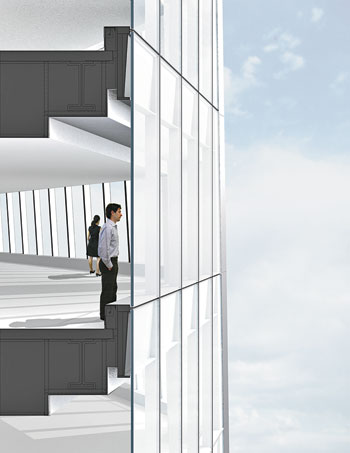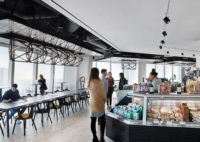New York City
Thirteen years, an ocean of cash, and such a torrent of words that by the end nearly everyone had averted their eyes: finally, One World Trade Center, by Skidmore, Owings & Merrill (SOM), officially the tallest building in the Western Hemisphere, on the 16 acres of Ground Zero, has opened.
Beyond that, what we see in this building will capture our own reflected image, revealing both something of what is physically there and something of who we are. Tourists and city dwellers will first assess the overall design (do I like the way it looks?) and urbanism (does it work in the neighborhood?). Users will value the location, access to public transportation, and the quality and flexibility of its spaces. Design and engineering professionals will note advances in technology and materials. Developers will see the bottom line.
What anyone sees in the building, however, must inevitably reflect the story of the site's and the project's history. The horrific events spawning this building's inception, the massive outlay of public money devoted to its execution, the efforts of thousands of people, including community leaders, design professionals, city planners, state bureaucrats, and ordinary citizens who offered and grappled with ideas for the World Trade Center's rebuilding after 9/11 . . . it all makes One WTC a singular project, larger than its clients, financiers, architects, and tenants; larger even than survivors' families and New York City's residents. One WTC is a project fraught with the agony of meaning. Everyone had every right to expect a major civic icon.
Which we did not get. This is a fair-to-middling commercial office building with some notable good features. Viewed from afar, One WTC's sheer, mullionless glass planes cut a strong figure into the skyline, restoring the balance between Manhattan's Midtown and downtown and visually anchoring the new World Trade Center complex. Urbanistically, the restoration of Fulton and Greenwich streets (obliterated by the original World Trade Center complex) will help draw pedestrian life to the 9/11 Memorial plaza, especially as the streets are closed to ordinary vehicular traffic. Professionals will be impressed by the technological advances, such as the large panels of thick low-iron glass that facilitated the facade's appearance of flat sheerness, or sheer flatness, without the 'oil-can effect' that makes so many glazed tall buildings look chintzy. People who work in the building will rejoice in the abundant natural light admitted through its floor-to-ceiling windows'on most days, little artificial illumination is needed'and its open, columnless spaces, made possible by the reinforced concrete core surrounded by a steel frame (see sidebar). And from inside its upper stories, the views are just spectacular.
All this is not to be dismissed. It is testimony to the successful collaboration, even in these complex, high-stakes circumstances, among the lead designer, David Childs, and his team at SOM, and the client, the Port Authority of New York and New Jersey. We can take heart that to accomplish this project, many people committed to collaborating, and collaborated well.
But that cannot be the end of this story. One WTC is not just a private commercial office tower. It is a publicly as well as privately financed project with a cost of $3.9 billion that was appropriately promised and promoted to the families of 9/11's victims, traumatized New Yorkers, Americans, and citizens of the world as a symbol of the city's resilience and the country's strength. Nothing less than a magisterial civic icon was in order'and we could have had one. For several years, the media and the public swarmed over inspired, or at least good, proposals for what the site could become. The Lower Manhattan Development Corporation (LMDC), a governmental body, reportedly favored one superb project, by the collaborative THINK, which would have turned the site into a public amenity. Another proposal, less good but at least acceptable, by Daniel Libeskind, was officially selected, under pressure from then New York State Governor George Pataki. And a third, excellent design by the world's best commercial skyscraper architect, Norman Foster, stood ready to hand.
So if we assess One WTC from the perspective of what feasibly could have been and what feasibly should have been there? Get out your handkerchiefs.
As a civic icon and a public monument, what One WTC mostly represents is a gross betrayal of public trust. In no way is it remarkable. No one's heart will soar at its prospect. The base is horrendously clunky, the overall composition disjointed and incoherent. It crashes into rather than meets the ground. The proportions of its white-Carrera stripped neoclassical lobby are oppressively tight, so that upon entering we confront all planes and no grace'a sequence of thick walls, from the podium's imposing perimeter to the hefty cores'all concessions to security concerns.
The mantle of responsibility for One WTC's failure falls on individual actors and their decisions, some of whom are known, and others not. Inexcusable Decision No. 1 was Pataki's unilateral choice of Libeskind, who was then inexperienced in designing commercial towers. This inexperience and the nature of the One WTC public-private partnership with the developer Larry Silverstein (who later left the project) created an opportunity for Silverstein to bring in his architect of choice, SOM's David Childs.
Other actors may be nameless but not blameless: Inexcusable Decision No. 2 was the insistence of New York City's police department that this supertall tower be built to security specifications resembling those of a U.S. embassy on foreign soil. Building a 104-story skyscraper this way is ridiculous. It projects cowardice, not strength; as one architect involved in its design told me, we might as well live underground.
Inexcusable Decision No. 3 was the belief of the Durst Organization'the developer who acquired a stake in One WTC in 2010'in its incontrovertible right to meddle with SOM's design. Public-private partnerships are all structured differently. This one was structured so that the private partner, along with the Port Authority, could compromise the design'without formal public review'by making decisions that would be likely to maximize its profit. These included scuttling the prismatic glass intended to clad the podium rather than giving Childs and his team the leeway to identify the right manufacturer. It included an 11th-hour modification, also to the podium; it originally had chamfered corners that would have both mitigated'if not entirely resolved'the base's cloddishness and resonated with the design of the shaft. And it included Durst's cancellation of the faceted and tapering radome spire.
Public-private partnerships must be structured so that the public's interest is tenaci-ously safeguarded. At One WTC, it was not. Politicians, real-estate developers, police commissioners'many people are ignorant of the public value of great design. These people should not be making key design decisions without an independent design review. That many lost patience with One WTC'in the end, people just wanted it done'is no excuse. This building should never have become what it is: a failed project by an excellent design firm, and a symbol of American political incompetence, private ignorance, and greed. Surely New York City and the public deserve better than this.
Louis Kahn’s Situated Modernism and Anxious Modernisms.
CLOSE-UP
SECURITY MEASURES

|
| Photo © James Ewing |
| The large glazing units span from floor to floor without mullions or spandrels, providing unimpeded views, especially from the upper floors. The configuration also maximizes daylighting. |
Some of the security features at the World Trade Center and the recently opened office tower One WTC are hard to miss. For example, it is difficult to overlook the formidable barricades and guard booths preventing cars from entering the 16-acre Ground Zero site. And at the skyscraper's entrances, only the most inattentive visitors will not perceive the building's beefy, 28-inch-thick podium walls, even though the high-strength concrete base has been camouflaged on the exterior behind metal louvers and glass fins and the lobby interior has been sheathed in Carrera marble.
While these measures are obvious, most of the building's other security and life-safety features are as inconspicuous as they are robust, such as the building's reinforced-concrete shear-wall core surrounded by a steel moment frame designed to prevent progressive collapse. The elements enclosed within the core include exit stairs that are more than 60 percent wider than required by code and are pressurized to keep smoke out, a separate pressurized stairwell for first responders, and a 'fireman's lift''an elevator that functions as a service elevator during day-to-day operations but is equipped with water-resistant controls and a second door that opens onto a pressurized, dedicated fireman's lobby.
Even the high-performance curtain wall, which is responsible for the office spaces' generous daylighting, contributes to the tower's security. The extra-large insulated glazing units (IGUs)'5 feet wide and 13 feet 4 inches tall'which span the full floor-to-floor height without intermediary mullions or spandrels, have extra-thick outer lites. These are a minimum of 3/8 inches (standard thickness is 1/4 inch) to help keep the glass surface smooth and flat. The inner lites, meanwhile, are laminated, and their thickness varies depending on location: the glass in some areas is thicker than others due to security concerns.
PeopleClient/Owner: 1 World Trade Center LLC, a wholly owned corporation held by The Port Authority of New York and New Jersey and The Durst Organization
Architect:
Personnel in architect's firm who should receive special credit:
SOM Team Members 2005-present
Engineers:
Consultant(s):
Lighting:
Acoustics: Cerami & Associates
Other: General contractor: Construction Manager: Tishman Construction Corporation / AECOM Program Manager: STV, Inc.
Photographer(s):
Iwan Baan Gross square footage: 3,467,820 square feet Project cost: $3.9 billion Completion date: November 2014 |
Products
Structural system Concrete: Collavino Construction Group
Exterior cladding Podium Glass (glass fins): Interpane Podium glass fin processor: Bischoff Glasstechnik AG Stainless Steel Corners: Pohl Inc. of America Lobby Glass Walls: APG International Curtain wall: Benson Industries LLC Podium: Permasteelisa North America
Other cladding unique to this project:
Special interior finishes unique to this project: Lobby Stone (Masabi Granite): Cold Spring Granite Lobby Stone (Larissa White Marble): Savema Podium stone: Mount Airy Granite
Lighting Podium LED Lighting: Philips Color Kinetics
Conveyance
Plumbing
Add any additional building components or special equipment that made a significant contribution to this project: Mechanical: ASM Plumbing and Heating Electrical: Five Star Electric Fire Protection: Rael Ornamental Metal: Airflex Firestopping: Hilti Fireproofing: Grace Millwork: Bauerschmidt & Sons
|
















Post a comment to this article
Report Abusive Comment